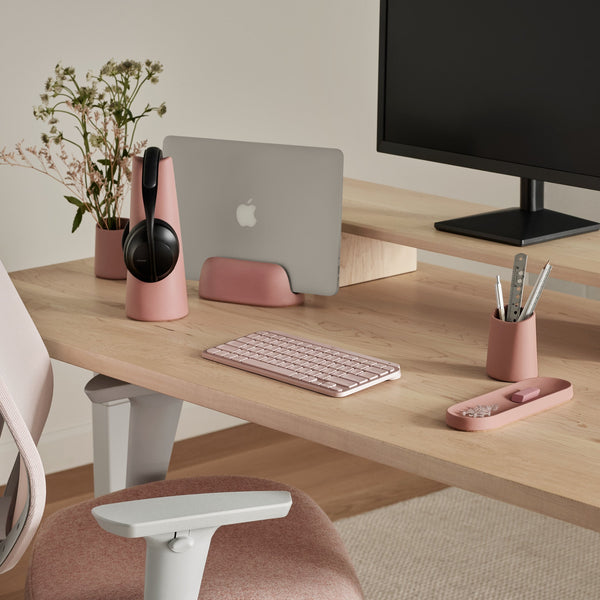Laptops are great for getting work done on-the-go, but let’s be honest: they don’t exactly encourage great posture. If you find yourself often hunched over, completely engrossed in your work, you’re not alone. While this stance may seem to go hand in hand with productivity, waking up the next day with aches and pains in your body is anything but productive.
The good news is that bad posture is just a bad habit, and it’s possible to break up with bad habits. The not-so-good news is that the cord isn’t easily cut overnight. Here are some easy tips to get the correct posture for a safe laptop use.
1. Say goodbye to slouching
While you’re reading this, take a moment to pause and be conscious of how you are sitting. Are you slouching? For many of us, this is our natural stance. We become so accustomed to slouching that it feels most comfortable, despite it being bad for us.
But what is good posture ? Here are a few tips to straighten up your position while working :
-
Keep your shoulder blades pulled back and your chest opened.
-
Sit so that your ears fall in line with your shoulders.
-
Uncross your legs and place your feet flat on the floor.
-
Keep your back straight, and pay attention to your neck posture.
It may feel unnatural at first, but this is actually a good thing. Your body is recognizing a change in habits. In no time, sitting without slouching should feel like your new normal.
Pro tip: Need a little bit of help? Try the Upright Pro! It's a tiny wearable device that sticks on your back and gives you a gentle vibration to remind you to correct your posture whenever you slouch.
2. Find a laptop set-up that is right for you
The name “laptop” is deceiving – your lap is actually not a good place to put your computer at all! To keep your proper posture intact, your laptop should be placed so that the middle of the screen is at your eye level.
If your desk is not already at the ideal height for you, it may be worthwhile investing in a laptop stand or a desk monitor stand. Depending on your needs, laptop stands come in all shapes and sizes, from permanent laptop stands to portable ones that are ideal for people who travel.
Laptop height is not the only contributing factor that can affect your posture lead to negative consequences like neck pain. Here are some other things to consider when setting up a laptop:
- Font size. Too small of font may have you leaning forward and squinting!
- Screen size (usually the larger, the better).
- Screen brightness and tint. If you are straining to see the words on your screen, it may cause you to squint and lean in.
- Placement of your laptop on your desk. It shouldn’t be too close or too far away from the edge of the table – around 4 to 6 inches is a good distance.
3. Invest in the right ergonomic equipment
Beyond the laptop stand, there are many pieces of ergonomic equipment that can help you better your posture. Here are some examples:
- Invest in a sit-stand desk. Standing desks have been making waves in recent years and for good reason. A sit-stand desk provides the perfect mixture of sitting and standing, and discourages stagnation.
- If you’re standing at your desk, consider the use of an anti-fatigue mat.
- Invest in a wrist pad.
- Purchase a proper keyboard and mouse. It is better to use a separate mousepad and keyboard over the one that comes built into your laptop, as this allows you more flexibility.
- Find the right office chair for you. Everyone is different, but the right chair should offer height and depth that is right for you. A great option is an ergonomic chair such as the YouToo.
4. Exercise to improve posture
The body is an ecosystem, and getting enough exercise has a positive effect on your posture. Here are some posture exercises ideas for your recommended daily routine, easy to perform even through a busy workweek:
-
Take periodic breaks where you walk around your office, or even around the office parking lot.
-
Stretch every morning upon waking up, and every night before going to bed.
-
When working, raise your eyes away from the screen and move gently, doing a few neck posture exercises.
-
Join a gym or train at home, and opt for a training program designed to reinforce back strength.
-
If your office does not already have a similar initiative in place, suggest group yoga or pilates classes.
Looking for the best exercises to improve your posture? Check out our blog article featuring some good easy standing and desk exercises to revitalize your work routine.
5. Favour good sleeping posture
Would you believe us if we told you that part of your good posture routine is sleeping? It may seem too good to be true, but by getting a proper sleep you would actually be accomplishing a lot.
Looking for the best sleeping posture? Here are some tips for getting the most out of your shuteye :
-
If you can, try to fall asleep on your back, with a pillow underneath your knees. Experts say that it may be the best position to sleep, though sleeping on your side with a pillow between your knees is also acceptable.
-
Try to establish a calming, relaxing nighttime routine. Yes, this means some screen-free time before bed. Reading a book in bed or listening to some calming podcasts or music can actually help you to sleep well.
-
Try cutting out any caffeine for at least 6 hours leading up to bedtime.
-
If you find you are having a hard time getting the recommended amount of sleep – for adults that’s seven to eight hours – try moving up your bedtime. Going to bed even just an hour earlier can make a big difference for some people, and contribute to better overall health and energy performance.
As you can see, good posture can involve some effort to be properly acquired. By adopting small habits and investing in the right equipment, such as an ergonomic standing desk, you can take a big step towards better health and energy performance. Take the first step today, and your body will thank you!






Leave a comment